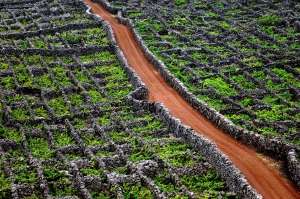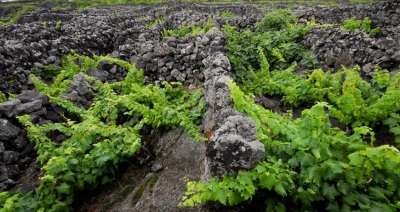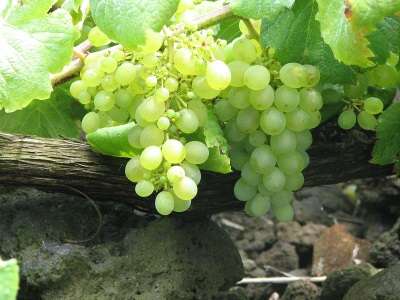|

"Pedra - por cima da terra, por baixo da terra, a transbordar da terra nos abismos do oceano! (...) Mas os desgraçados ergueram a fronte. Eram homens. Sucumbiram - mas combatendo, braços entesados e mãos crispadas, a grande batalha contra as pedras negras da ilha."
Dias de Melo, Pedras Negras

Paisagem da cultura da vinha, Património da Humanidade
Construção dos Currais
No Pico, a maldição da terra - apenas 3,4% do solo era arável - aguçou o engenho e a tenacidade dos homens.
Com a ajuda de picaretas, cunhas, marrões, barras, alviões e piques, o homem do Pico triunfou perante a adversidade de uma natureza hostil e de um chão inclemente, transformando pedra improdutiva no seu modo de sustento.
Foi preciso partir lava, quebrar rochas, furar o solo pedregoso, fazer caminhos e construir uma teia interminável de abrigos para defender as videiras, que eram plantadas em covas. Nas covas, era lançado um cesto de terra e plantado um bacelo, inclinado sobre a superfície, mais bem adaptado para rastejar do que para trepar.
No inverno, plantava-se, enxertava-se, repunham-se as falhas do ano anterior, rapava-se o chão (a terra era mexida, utilizando enxadas e pequenos alviões) e podavam-se as videiras.
Durante a primavera e o verão, a vinha era enxofrada, sulfatada periodicamente, levantada com o apoio de pedras e estacas de madeira ou de cana, e desfolhada.
Durante o verão, o Sol ia amadurecendo os cachos que, ao longo da noite, recebiam o calor que o basalto mantinha em ambiente de estufa natural.
A colheita ocorria entre os finais de agosto e princípios de setembro.
Este milagre picaroto tornou possível transformar vastas extensões de pedra em férteis campos de vinha, constituídos por um rendilhado de muros de lava negra - os currais.
Este trabalho de edificação de pedra solta, arrancada a pulso dos mantos de lajido e do chão pedregoso, constituiu um esforço sobrehumano, com dimensão de epopeia, que está hoje classificado como Património da Humanidade.

As videiras plantadas e protegidas nos seus currais
Propriedades óticas dos materiais
Os materiais possuem três propriedades ópticas básicas: absorvem a luz, refletem-na e transmitem-na. Nenhum material é perfeitamente refletivo, transparente ou absorvente; todas as substâncias têm estes três atributos em algum grau. Além disso, o desempenho ótico de um material depende do comprimento de onda da luz em questão. O vidro de janela, por exemplo, é altamente transparente à luz visível, mas absorve infravermelhos, dando às estufas a capacidade de conter calor.
Cores e tons
A cor e o tom de um material afetam a quantidade de luz que ele absorve ou reflete; as cores escuras refletem menos luz para os nossos olhos, por isso, absorvem-na em maior quantidade. Um material preto e liso sem reflexos brilhantes absorve a maior parte da energia solar. Por outro lado, as cores claras refletem mais luz do que as escuras, e o branco é o que reflete mais.
Ao construir um piso para uso solar ou usar uma superfície de pedra que se quer manter aquecida, é importante saber que tipo de rocha retém melhor o calor. A capacidade de reter calor é uma função da capacidade calorífica e de densidade da pedra. Outro fator na escolha da pedra pode ser a rapidez com que esta transfere calor, a chamada condutividade térmica. A pedra que armazenar mais calor e tiver maior condutividade térmica será a que absorverá melhor e mais rapidamente o calor.
A densidade energética da pedra
A característica mais importante de uma pedra que deve reter calor é a medida da sua capacidade de calor. O calor específico de um material é a quantidade de energia necessária para elevar um quilo de material em um grau centígrado.
A segunda característica mais importante de uma pedra usada para absorver o calor é a sua densidade. Para dois materiais de pedra com o mesmo calor específico, a rocha mais densa será menor e terá a mesma energia térmica.
A densidade de energia da pedra é o calor específico multiplicado pela sua densidade numa base unitária. Isto dá um número que mostra quão bem uma rocha pode armazenar calor, se as rochas forem do mesmo tamanho. A pedra com a maior densidade de energia terá a maior capacidade de absorver calor, para uma determinada espessura ou tamanho.
Quais as pedras que absorvem mais calor?
Para materiais naturais comuns, as pedras com maior densidade energética são o gipso, a pedra sabão, o basalto, o mármore, o calcário, o arenito e o granito.
Para materiais comuns usados pelo Homem na construção, a pedra com a maior densidade de energia é o tijolo de fogo, seguido do asfalto, do cimento e do tijolo normal. Um cimento feito com basalto teria uma densidade de energia maior do que um feito com calcário.
Condutividade térmica das pedras
Qualquer material tem a capacidade de transferir calor para um material mais frio. A taxa em que isso ocorre é chamada de condutividade térmica. Materiais com maior transferência de condutividade térmica aquecem mais prontamente. Esta é uma das razões pelas quais um piso de mármore parece mais frio do que um piso de madeira, embora possam estar no ambiente à mesma temperatura.
Se uma pedra tiver uma alta condutividade térmica, também transferirá o calor para um local mais frio o mais rapidamente possível.
Qual a pedra que absorve mais calor mais rapidamente?
Algumas pedras naturais com alta densidade de energia e excelente condutividade térmica são a pedra-sabão (de longe a melhor) e o mármore. Estas são talvez as melhores pedras para absorver grandes quantidades de calor rapidamente. Alguns tipos de granito podem ser bons condutores de calor, mas não são ótimos para armazenar calor.
Embora o gipso mantenha bem o calor, ele age mais como um isolante do que como um condutor de calor. O basalto, apesar de excelente para manter o calor, transfere o calor lentamente.

A uva, nascida do magma
A earthcache
Para poderes registar esta earthcache, terás de responder às perguntas, enviando-as por e-mail ou mensagem através do meu perfil. Para tal, será necessário visitar o Museu do Vinho, que está aberto nos seguintes horários:
Horário de verão (01 de abril a 30 de setembro)
3.ª a Domingo: 10h00 - 17h30
Encerrado à 2.ª feira
Horário de inverno (01 de outubro a 31 de março)
3.ª a Domingo: 09h30 - 17h00
Encerrado à 2.ª feira
1- Qual a origem e o nome da rocha usada para construir os currais?
2- Explica a influência da cor desta rocha na sua escolha para a construção dos currais.
3- Olhando para as rochas existentes no local, e analisando-as visualmente e com as mãos, enumera três fatores que levaram ao seu aproveitamento na criação dos currais e que contribuem para o desenvolvimento das videiras.
4- Os currais, de forma quadrangular, tem uma área de quantos metros quadrados?
5- Desde 8 de janeiro, 2023, é obrigatório uma foto nas coordenadas no GZ, a comprovar que o geocacher que faz o registo na página esteve no local, e não fora do museu.
|
|

"Stone - over the earth, under the earth, overflowing from the earth in the abyss of the ocean! ... But the wretched ones raised their foreheads." They were men, they succumbed - but fighting, arms clenched and clenched hands, the great battle against the black stones of the island. "
Dias de Melo, Pedras Negras

Landscape of vineyard culture, World Heritage Site
Construction of the corrals
At Pico, the curse of the land - only 3.4 percent of the soil was arable - sharpened the ingenuity and tenacity of men.
With the help of pickaxes, wedges, bucks, bars, and pillars, the Pico man triumphed in the face of the adversity of a hostile nature and an inclement ground, turning unproductive stone into his mode of sustenance.
It was necessary to break lava, to break rocks, to pierce the stony ground, to make paths and build an endless web of shelters to defend the vines, which were planted in pits. In the pits, a basket of earth was thrown and planted a bacelo, leaning on the surface, better adapted to crawl than to climb.
In winter, it was planted, grafted, the faults of the previous year were rebuilt, the ground was shaken (the earth was stirred, using hoes and small tongues) and pruned the vines.
During spring and summer, the vineyard periodically sulphated, raised with the support of stones and wood or cane stakes, and defoliated.
During the summer, the sun ripened the grapes that, throughout the night, received the heat that the basalt maintained in a natural stove environment.
Harvesting took place between the end of August and the beginning of September.
This picaroto miracle made it possible to transform vast stretches of stone into fertile vineyards, made up of a lacy black lava wall - the corrals.
This work of building loose stone, wrenched from the mantles of slab and stony ground, was a superhuman effort, of epic dimension, which is now classified as a World Heritage Site.

The vines, planted and protected in their corrals
Optical properties of materials
The materials have three basic optical properties: they absorb the light, reflect it and transmit it. No material is perfectly reflective, transparent or absorbent; all substances have these three attributes to some degree. In addition, the optical performance of a material depends on the wavelength of the light in question. Window glass, for example, is highly transparent to visible light, but absorbs infrared, giving greenhouses the ability to contain heat.
Colors and shades
The color and shade of a material affect the amount of light it absorbs or reflects; the dark colors reflect less light to our eyes, so we absorb it in greater quantity. A smooth black material with no bright reflections absorbs most of the solar energy. On the other hand, light colors reflect more light than dark ones, and white reflects more.
When building a floor for solar use or using a stone surface that you want to keep warm, it is important to know what type of rock best holds the heat. The ability to retain heat is a function of the heat capacity and density of the stone. Another factor in the choice of stone can be the speed with which it transfers heat, the so-called thermal conductivity. The stone that stores more heat and has higher thermal conductivity will be the one that will absorb heat better and faster.
The energetic density of the stone
The most important characteristic of a stone that must retain heat is the measurement of its heat capacity. The specific heat of a material is the amount of energy needed to raise one pound of material by one degree centigrade.
The second most important characteristic of a stone used to absorb heat is its density. For two stone materials with the same specific heat, the denser rock will be smaller and have the same thermal energy.
The energy density of the stone is the specific heat multiplied by its density on a unit basis. This gives a number that shows how well a rock can store heat if the rocks are the same size. The stone with the highest energy density will have the greatest capacity to absorb heat, for a certain thickness or size.
Which stones absorb the most heat?
For ordinary natural materials, the stones with the highest energetic density are gypsum, soapstone, basalt, marble, limestone, sandstone and granite.
For common materials used by man in construction, the stone with the highest energy density is fire brick, followed by asphalt, cement and normal brick. A basalt cement would have a higher energy density than limestone.
Thermal conductivity of stones
Any material has the ability to transfer heat to cooler material. The rate at which this occurs is called thermal conductivity. Materials with higher thermal conductivity transfer heat up more readily. This is one of the reasons why a marble floor looks cooler than a hardwood floor, although they may be in the room at the same temperature.
If a stone has a high thermal conductivity, it will also transfer the heat to a cooler place as quickly as possible.
Which stone absorbs more heat faster?
Some natural stones with high energy density and excellent thermal conductivity are soapstone (by far the best) and marble. These are perhaps the best stones to absorb large amounts of heat quickly. Some types of granite can be good heat conductors, but they are not great for storing heat.
Although the gypsum holds the heat well, it acts more like an insulator than a heat conductor. Basalt, while excellent for maintaining heat, transfers heat slowly.

The grapes, born from magma
The earthcache
To be able to register this earthcache, you will have to answer the questions by sending them by email or message through my profile. To do this, you will need to visit the Wine Museum, which is open at the following times:
Daylight Saving Time (April 1 to September 30)
Tuesday to Sunday: 10:00 a.m. to 5:30 p.m.
Closed on Mondays
Winter time (October 1 to March 31)
Tuesday to Sunday: 09:30 a.m. to 5 p.m.
Closed on Mondays
1- What is the origin of the rock used to build the corrals? What's its name?
2- Explain the influence of the color of this rock in its choice for the construction of the corrals.
3- Looking at the existing rocks in the place, and analyzing them visually and with the hands, enumerate three factors that have led to its use in the creation of corrals and contribute to the development of the vines.
4- The corrals, of quadrangular form, have an area of how many square meters?
5- Since January 8, 2023, it's mandatory to post a photo taken on the GZ by the geocacher who makes the log, not outside the museum.
|